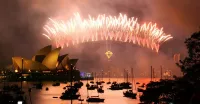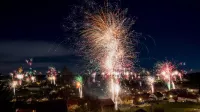Rio de Janeiro is the capital of the state of Rio de Janeiro. It stands as Brazil's second-most populous city and ranks as the sixth-most populous in the Americas. Known for its iconic beaches like Copacabana and Ipanema, the towering Christ the Redeemer statue atop Corcovado Mountain, and the annual Carnival celebration, Rio is a major cultural and economic center in Brazil. Its natural setting, blending mountains and beaches, contributes to its global appeal. However, the city also faces challenges related to socioeconomic disparities and infrastructure.
1902: Pereira Passos became mayor
In 1902, Pereira Passos was named mayor and imposed reforms to modernize the city, demolishing cortiços and building new structures inspired by Paris.
1904: Formal creation of the Bangu Football Club
In 1904, the Bangu Football Club was formally created.
1905: Consolidation and Electrification of Streetcar Transit
After 1905, the consolidation and electrification of Rio's streetcar transit system facilitated the expansion of the city to the north and south.
1905: Construction of the Theatro Municipal
In 1905, construction of Rio de Janeiro's Theatro Municipal began, following the designs of architect Francisco Pereira Passos.
1909: Inauguration of the Teatro Municipal
In 1909, the Teatro Municipal in Rio de Janeiro was inaugurated, featuring close to 1,700 seats and rich furnishings.
1910: Revolt of the Lash
In 1910, Rio de Janeiro experienced the Revolt of the Lash, where Afro-Brazilian crew members in the Brazilian Navy mutinied against corporal punishment.
1918: Monsignor Ivo Antônio Calliari's birth
In 1918, Monsignor Ivo Antônio Calliari, who coordinated the design and execution of the Rio de Janeiro Cathedral, was born.
1918: Birth of Monsignor Ivo Antônio Calliari
Monsignor Ivo Antônio Calliari, who coordinated the design and execution of the Cathedral of São Sebastião do Rio de Janeiro, was born in 1918.
1920: Portuguese population in Rio
The Brazilian census of 1920 showed that 39.7% of the Portuguese who lived in Brazil lived in Rio de Janeiro.
1922: Copacabana Fort revolt
In 1922, the Copacabana Fort revolt, a march against the Old Republic's coronelism and café com leite politics.
1930: Brazilian Revolution of 1930
In 1930, the Brazilian Revolution started the Vargas Era.
1931: Data from the Brazilian National Institute of Meteorology
Since 1931, data from the Brazilian National Institute of Meteorology (INMET).
August 18, 1933: Absolute minimum temperature
On August 18, 1933, the absolute minimum temperature recorded in Rio de Janeiro was 6.4 °C at the meteorological station in the Bangu neighborhood.
1936: Rio made their first bid for the 1936 Summer Olympics
Rio de Janeiro made their first bid for the 1936 Summer Olympics, but lost to Berlin.
1950: 1950 FIFA World Cup
In 1950, Rio de Janeiro hosted matches for the FIFA World Cup, including the match where Uruguay defeated Brazil 2-1 at the Maracanã Stadium.
1950: Maracanã Stadium hosted the FIFA World Cup Final
In 1950, the Maracanã Stadium held the finals of the FIFA World Cup.
1950: World Cup final at Maracanã
In 1950, the Maracanã stadium hosted the World Cup final, accommodating nearly 199,854 people, marking its highest capacity.
1954: FIBA Basketball World Championship
In 1954, the Ginásio do Maracanãzinho in Rio hosted the official FIBA Basketball World Championship.
1955: Juscelino Kubitschek elected president
In 1955 Juscelino Kubitschek was elected president partially on the strength of promises to build a new capital.
1956: Melbourne hosted the games
In 1956, Melbourne hosted the games, being the first city in the southern hemisphere outside of Australia to host the games.
1960: Brasilia replaces Rio as capital
In 1960, Brasília replaced Rio de Janeiro as the Brazilian capital.
1960: Capital Transferred to Brasília
In 1960, the capital of Brazil was officially moved from Rio de Janeiro to Brasília.
1960: End of federal capital position
In 1960, the city ceased to be the federal capital when the seat of government was transferred to Brasília.
1960: Capital officially moved to Brasília
On April 21, 1960, the capital of Brazil was officially moved to Brasília.
1960: Rio de Janeiro second-most populous city
Since 1960, when it was surpassed by São Paulo, the city of Rio de Janeiro has been the second-most populous city in Brazil.
1961: Tijuca National Park established
Since 1961, the Tijuca National Park has been a National Park.
1963: FIBA Basketball World Championship
In 1963, the Ginásio do Maracanãzinho in Rio hosted the official FIBA Basketball World Championship.
1964: Coup d'état
After the 1964 coup d'état, the city-state was the only state left in Brazil to oppose the military.
1968: End of Rio de Janeiro as a capital
In 1968, Rio de Janeiro ceased to be the capital of the Republic of the United States of Brazil.
1968: Off-shore oil exploration begins
In 1968, offshore oil exploration began in the Campos Basin, which became Brazil's main site for oil production, leading many oil and gas companies to be based in Rio de Janeiro.
February 26, 1971: Record for rainfall
On February 26, 1971, the record for rainfall within 24 hours is 349.4 mm.
1975: "The Fusion"
In 1975, a presidential decree known as "The Fusion" removed the city's federative status and merged it with the State of Rio de Janeiro, with the city of Rio de Janeiro replacing Niterói as the state's capital.
1977: CNBB headquarters in Rio
Until 1977, the Regional Episcopal Council Leste I of the National Conference of Bishops of Brazil (CNBB) was headquartered in Rio.
1978: Formula One Brazilian Grand Prix
From 1978, the Jacarepaguá circuit in Rio de Janeiro was the site for the Formula One Brazilian Grand Prix.
1979: Inauguration of the Cathedral of São Sebastião do Rio de Janeiro
In 1979, the Cathedral of São Sebastião do Rio de Janeiro, or Metropolitan Cathedral, was inaugurated in the central region of the city. Its facilities house the Archdiocesan Museum of Sacred Art and the Archdiocesan Archive.
1979: Inauguration of the Rio de Janeiro Cathedral
In 1979, the Rio de Janeiro Cathedral was inaugurated in the central region of the city, housing a collection of great historical and religious value.
January 14, 1984: Maximum temperature
On January 14, 1984, the same station recorded a maximum temperature of 43.1 °C.
1985: Brazil's return to democracy
Brazil's return to democracy in 1985 allowed for a new music expression which promoted creativity and experimentation in expressive culture, in a wave of Rock'n'roll.
1985: WCT/WQS surfing championships
From 1985, WCT/WQS surfing championships were contested on the beaches of Rio.
1985: Tourism sector decline
In 1985, Rio de Janeiro's tourism sector began to decline with annual international airport arrivals dropping from 621,000.
1985: Santa Teresa Tram designated historic monument
In 1985, the Santa Teresa Tram was designated a national historic monument.
1985: First Rock in Rio festival
In 1985, the first Rock in Rio music festival, conceived by Roberto Medina, took place. It was recognized as the largest music festival in Latin America and the world, with 1.5 million attendees.
1989: Formula One Brazilian Grand Prix
Until 1989, the Jacarepaguá circuit in Rio de Janeiro was the site for the Formula One Brazilian Grand Prix.
1992: Earth Summit
In 1992, Rio hosted the Earth Summit, a United Nations conference to fight environmental degradation.
1993: Hotel occupancy decline
By 1993, the decline in the tourism sector continued, with the average hotel occupancy in Rio de Janeiro dropping to 50%.
1995: MotoGP Brazilian Grand Prix
From 1995, Rio de Janeiro hosted the MotoGP Brazilian Grand Prix.
1995: School Statistics in Rio
In 1995, Rio had 1,033 primary schools, 370 secondary schools, and 53 university-preparatory schools. The city also had six major universities and 47 private schools of higher learning.
1998: Start of official records for police killings
Official records for police killings started being tracked in the state of Rio de Janeiro in 1998.
1999: Rio de Janeiro International Film Festival held annually
Since 1999, the Rio de Janeiro International Film Festival has been held annually.
2000: Sydney hosted the games
In 2000, Sydney hosted the games, being the first city in the southern hemisphere outside of Australia to host the games.
2001: Change in New Year's Eve fireworks launch location
Starting in 2001, fireworks for Copacabana beach's New Year's Eve parties began to be launched from boats to improve the safety of the event.
2001: WCT/WQS surfing championships
Until 2001, WCT/WQS surfing championships were contested on the beaches of Rio.
March 2004: Deactivated meteorological station
In March 2004, the meteorological station in the Bangu neighborhood was deactivated.
2004: First Rock in Rio edition abroad
In 2004, the Rock in Rio festival held its first edition abroad in Lisbon, Portugal.
2004: Rio made bids for the 2004 Summer Olympics
Rio de Janeiro made bids for the 2004 Summer Olympics, but failed to become a candidate city. Those games were awarded to Athens.
2004: Planned opening of Cidade das Artes
The Cidade das Artes was originally planned to open in 2004.
2004: MotoGP Brazilian Grand Prix
Until 2004, Rio de Janeiro hosted the MotoGP Brazilian Grand Prix.
2005: Monsignor Ivo Antônio Calliari's death
In 2005, Monsignor Ivo Antônio Calliari, who coordinated the design and execution of the Rio de Janeiro Cathedral, died.
2005: Research and Development Center
In 2005, Rio de Janeiro was the second-largest center of research and development in Brazil, accounting for 17 percent of national scientific output.
2005: Death of Monsignor Ivo Antônio Calliari
Monsignor Ivo Antônio Calliari, who coordinated the design and execution of the Cathedral of São Sebastião do Rio de Janeiro, died in 2005.
2006: Brazilian cinema production
In 2006, studios in Rio de Janeiro were responsible for 65% of Brazilian cinema production, generating 91 million reais in federal funds through tax incentive laws.
July 2007: Rio hosted the XV Pan American Games
In July 2007, Rio de Janeiro successfully organized and hosted the XV Pan American Games.
2007: Preparations to host the 2007 Pan American Games
As part of its preparations to host the 2007 Pan American Games, Rio built a new stadium, Estádio Olímpico João Havelange.
2007: Pan American Games
In 2007, Rio de Janeiro was the host of the Pan American Games.
2007: Policy Defining Municipality as Sanitation Provider
The 2007 policy defined the municipality of Rio de Janeiro as the provider of sanitation services, delegating the organization, supervision, and provision of services to third parties.
October 2008: IBGE Study on Rio's GDP
According to a study released in October 2008 by the IBGE, Rio de Janeiro's network of influence raised its share in GDP to 14.4%.
2008: Second Largest Municipal GDP
In 2008, Rio de Janeiro had the second largest municipal GDP in the country, and 30th-largest in the world, estimated at R$343 billion.
2008: Partnership to decontaminate the lagoon
In 2008, a public-private partnership was established to decontaminate the lagoon.
October 2009: Rio de Janeiro selected to host 2016 Summer Olympics
In October 2009, the International Olympic Committee selected Rio de Janeiro to host the 2016 Summer Olympics.
October 2009: Rio de Janeiro would host the 2016 Olympic Games and the 2016 Paralympic Games
On 2 October 2009, the International Olympic Committee announced that Rio de Janeiro would host the 2016 Olympic Games and the 2016 Paralympic Games.
2009: Autosomal DNA study in Rio de Janeiro
In 2009, an autosomal DNA study conducted in a poor suburb of Rio de Janeiro revealed that "pardos" were approximately 80% European in ancestry. The "whites" in the study showed little Amerindian or African admixture, challenging self-reported estimates.
2010: IBGE Census
According to the 2010 IBGE Census, there were 5,940,224 people residing in the city of Rio de Janeiro.
2010: Population concentration in Rio neighborhoods
According to the 2010 census, most of Rio de Janeiro's population was concentrated in eleven neighborhoods: Campo Grande, Santa Cruz, Bangu, Tijuca, Realengo, Jacarepaguá, Copacabana, Barra da Tijuca, Maré, Guaratiba and Taquara, together comprising 1.5 million inhabitants.
2010: Rio de Janeiro's GDP
In 2010, Rio de Janeiro's economy was the second-largest in Brazil, with a GDP of R$ 201.9 billion, making it the 30th largest in the world.
2010: Religion data in Rio de Janeiro
In 2010, data from the Brazilian Institute of Geography and Statistics (IBGE) showed that the population of Rio de Janeiro was diverse, with Catholic Christianity being the majority religion. Other religions followed, and 13.5% had no religion.
January 2011: Tornado-like phenomenon
In January 2011, a tornado-like phenomenon caused structural damage and long-lasting blackouts in the region.
July 2011: Rio hosted the 2011 Military World Games
From July 15 to 24, 2011, Rio de Janeiro hosted the 2011 Military World Games, the largest military sports event ever held in Brazil.
August 2011: Santa Teresa Tram derailment
In August 2011, a derailment on the Santa Teresa Tram resulted in six deaths, leading to the suspension of the tram service for system improvements.
March 2012: Pseudo-hail falls
In March 2012, pseudo-hail (granizo) falls in the same suburbs (Nova Iguaçu and surrounding areas, including parts of Campo Grande and Bangu).
December 26, 2012: Highest temperature in the city
On December 26, 2012, 43.2 °C was recorded at the Santa Cruz station, the highest temperature in the city.
2012: Opening of Túnel da Grota Funda
In 2012, the Túnel da Grota Funda opened, creating a public transit facility between Barra da Tijuca and Santa Cruz, reducing travel time to the region.
2012: United Nations Conference on Sustainable Development
In 2012, the city hosted the United Nations Conference on Sustainable Development.
2012: Rio made bids for the 2012 Summer Olympics
Rio de Janeiro made bids for the 2012 Summer Olympics, but failed to become a candidate city. Those games were awarded to London.
March 2013: Pseudo-hail falls
In February-March 2013, pseudo-hail (granizo) falls in the same suburbs (Nova Iguaçu and surrounding areas, including parts of Campo Grande and Bangu).
May 2013: High winds caused blackouts
In early May 2013, winds registering above 90 km/h caused blackouts in 15 neighborhoods of the city and three surrounding municipalities, and killed one person.
2013: Protest Movement
In 2013, high fares on Rio de Janeiro's public transportation significantly contributed to the high levels of social and economic inequality in the city and were the main motive of the protest movement.
2013: Maracanã Stadium hosted the FIFA Confederations Cup
In 2013, the Maracanã Stadium held the finals of the FIFA Confederations Cup.
2013: World Youth Day
In 2013, the city hosted the World Youth Day.
2013: Inauguration of Cidade das Artes
The Cidade das Artes, formerly known as "Cidade da Música", was finally inaugurated at the beginning of 2013.
2014: Rio's exports in 2014
As of 2014, Rio de Janeiro was the second-largest exporting municipality in Brazil, with a total of $7.49B (USD) worth of goods exported. The top exports were crude petroleum, semi-finished iron products, and semi-finished steel products.
2014: Delivery of new tram replicas
In 2014, delivery began on newly built replicas of the old Santa Teresa Tram cars.
2014: Maracanã Stadium hosted the FIFA World Cup Final
In 2014, the Maracanã Stadium held the finals of the FIFA World Cup.
2014: Providência Cable Car Opening
In 2014, the Providência Cable Car, running from Central do Brasil to Gamboa, first opened.
2014: Drought affected water supply
The Brazilian drought of 2014–2015 affected the entire metropolitan region's water supply.
January 2015: Pseudo-hail falls
In January 2015, pseudo-hail (granizo) falls in the same suburbs (Nova Iguaçu and surrounding areas, including parts of Campo Grande and Bangu).
July 2015: Santa Teresa Tram Reopening
In July 2015, after repairs and upgrades, about one-third of the Santa Teresa Tram line reopened.
2015: Drought affected water supply
The Brazilian drought of 2014–2015 affected the entire metropolitan region's water supply.
August 2016: 2016 Summer Olympics held in Rio
From August 5 to 21, 2016, Rio de Janeiro hosted the Summer Olympics.
September 2016: 2016 Summer Paralympics held in Rio
From September 7 to 18, 2016, Rio de Janeiro hosted the Summer Paralympics.
2016: Summer Olympics Noise Barrier/Wall of Shame
Around the time of the 2016 Summer Olympics, an 8 km barrier known as the Wall of Shame was built along the Linha Vermelha highway in Maré, ostensibly as a noise barrier.
2016: Olympic Games and the 2016 Paralympic Games
In 2016, Rio de Janeiro hosted the Olympic Games and the 2016 Paralympic Games.
2016: Host of the 2016 Summer Olympics and Paralympics
In 2016, Rio de Janeiro hosted the Summer Olympics and the Paralympics, becoming the first South American and Portuguese-speaking city to host the events.
January 2019: Santa Teresa Tram restored
In January 2019, the main section of the Santa Teresa Tram line was restored to its full pre-2011 length of 6 km.
2019: Police killings in Rio de Janeiro
In 2019, police in the state of Rio de Janeiro killed an average of five people each day, totaling 1,810 for the year. This was the highest number of police killings since official records started.
2020: National policy changes
In 2020, national policy changes for the universalization of sanitation kept the 2007 policy defining the municipality as the provider of sanitation service.
2021: Sewage treatment
As of 2021, only 65% of sewage was properly treated in Rio de Janeiro, with 35% being improperly discharged.
2022: Illicit Sewage Disposal
As of 2022, there were at least 400 illicit sewage disposal points in Rio de Janeiro's drainage network.
2022: Sewage Treatment Auction
In 2022, distribution and treatment of sewage of the Rio de Janeiro State Water and Sewage Company was divided into four blocks and auctioned to Aegea (Águas do Rio) and Iguá.
2022: Commute Time
In 2022, the average commute time for public transit in Rio de Janeiro was 67 minutes on a weekday, and the average distance traveled in a single trip with public transit was 11.4 km.
2022: Traffic Deaths
Rio de Janeiro had 694 traffic deaths in 2022, equivalent to 11 deaths per 100,000 inhabitants.
2023: Municipal Bus Lines
As of 2023, Rio de Janeiro has 354 municipal bus lines serving over 1.75 million passengers per day.
2024: Port of Rio de Janeiro Cargo
In 2024, the Port of Rio de Janeiro handled 15.5 million tonnes of cargo, including containerized cargo, iron and steel products, petroleum products, wheat, crude oil, and motor vehicles.
2024: G20 summit
In 2024, the city hosted the G20 summit.
2024: Cargo Handling at Private Port Facilities
In 2024, the private port facilities in Rio de Janeiro collectively handled significant amounts of petroleum products, iron, steel, coal, limestone, mineral oils, and petroleum coke.
January 2025: Paula Mattos branch reopening
The 1.7 km Paula Mattos branch to Largo das Neves of the Santa Teresa Tram, which was closed in 2011, reopened in January 2025.
September 2025: Creation of the Southwest Zone
On 9 September 2025, many neighborhoods that compound the former West Zone were set apart to create the Southwest Zone (Zona Sudoeste).
Mentioned in this timeline

Basketball is a team sport played on a rectangular court...
The United States of America is a federal republic located...

Fireworks are pyrotechnic devices primarily utilized for entertainment and aesthetic...

New Year's Eve observed on December st marks the final...
Australia officially the Commonwealth of Australia encompasses the Australian mainland...

Football is a family of team sports primarily involving kicking...
Trending
4 months ago Millennials Revolt: Coffee Badging Protests Return to Office Policies, Workplace Trends Emerge
22 days ago NYT Strands Hints and Answers for November 21, 2025: Solving the Puzzle
6 months ago Remembering Catherine Ann Jordan and Paul E. Caron: Portland Press Herald Obituaries
Charlotte Church is a Welsh singer-songwriter actress and television presenter from Cardiff known for her classical crossover music early in...

17 days ago Justin Bieber's 'Peaches' Cadillac from 1968 Goes to Auction; Bids Start High.
7 days ago Discord Checkpoint 2025: A Spotify Wrapped-like Recap for Gaming Habits in League of Legends.
Popular

Candace Owens is an American conservative political commentator and author...

Ilhan Omar is an American politician currently serving as the...

XXXTentacion born Jahseh Dwayne Ricardo Onfroy was a controversial yet...

Tom Cotton is an American politician and Army veteran currently...
The Kennedy Center Honors are annual awards recognizing individuals and...
Matt and Ross Duffer known as the Duffer Brothers are...